Tropical cyclones in 2000
 From Wikipedia - Reading time: 19 min
From Wikipedia - Reading time: 19 min
| Tropical cyclones in 2000 | |
|---|---|
| Year boundaries | |
| First system | Babiola |
| Formed | January 3, 2000 |
| Last system | Ando |
| Dissipated | January 9, 2001 |
| Strongest system | |
| Name | Hudah |
| Lowest pressure | 905 mbar (hPa); 26.72 inHg |
| Longest lasting system | |
| Name | Leon–Eline (third longest lasting tropical system on record) |
| Duration | 28 days |
| Year statistics | |
| Total systems | 140 |
| Named systems | 81 |
| Total fatalities | 1,875 |
| Total damage | $15.495 billion (2000 USD) |

During 2000, tropical cyclones formed in seven different areas called basins, located within various parts of the Atlantic, Pacific, and Indian Oceans. A total of 140 tropical cyclones formed within bodies of water known as tropical cyclone basins, with 81 of them being further named by their responsible weather agencies when they attained maximum sustained winds of 35 knots (65 km/h; 40 mph). The strongest storm of the year was Cyclone Hudah, peaking with a minimum pressure of 905 hPa (26.72 inHg), and with 10-minute sustained winds of 220 km/h (135 mph). The highest confirmed number of deaths from a storm was from Typhoon Kai-tak, which killed 188 people, however, Leon–Eline may have killed up to 722 people.[nb 1] The costliest storm was Saomai, which caused $6.3 billion in damage. The accumulated cyclone energy (ACE) index for the year 2000 (seven basins combined), as calculated by Colorado State University was 677.3 units.
There was an above-average number of storms during the year; the most active basin of the year was the Western Pacific, where a below-average 23 named storms formed. The Eastern Pacific and the North Atlantic were both relatively above-average, with 19 named storms forming in the Eastern Pacific and 15 in the North Atlantic. The Southern Hemisphere was also relatively average. Three Category 5 tropical cyclones were formed in 2000.
Global atmospheric and hydrological conditions
[edit]As the year began, a strong La Niña was peaking, with temperature anomalies going below −1.5 °C (−2.7 °F).[1] NOAA's May hurricane outlook indicated that overall global conditions were conducive to increased activity in the North Atlantic basin.[2] The La Niña began to weaken towards the latter part of 2000, with signs of weakening occurring as early as May.[3][4] Astride crossed over from the previous year, dissipating on January 3.
Summary
[edit]
North Atlantic Ocean
[edit]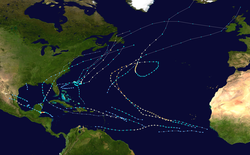
An average Atlantic hurricane season features 12 tropical storms, 6 hurricanes, and 3 major hurricanes, and features an Accumulated Cyclone Energy (ACE) count of 106. In 2000 in the North Atlantic basin, there were above-average numbers of named storms and hurricanes and an average number of major hurricanes. 2000 had an ACE count of 119, slightly higher than the average.
The season began with tropical depressions One and Two, both of which formed in June and affected no landmasses. Hurricane Alberto was the first named system of the 2000 season, intensifying into and peaking as a Category 3 hurricane. Alberto was the longest-lived storm of the 2000 Atlantic hurricane season. Four formed east of Florida, though it was not able to strengthen further and dissipated on August 11. Tropical Storm Beryl, Tropical Storm Chris, and Hurricane Debby all formed within a week of each other, with Beryl causing minimal damages in Mexico and Debby causing flooding throughout the Antilles. Tropical Storm Ernesto formed in the Main Development Region (MDR) and affected no landmasses, with Nine forming a week later in the Gulf of Mexico and making landfall on Sabine Pass. Hurricane Florence formed on September 10 and caused rip currents throughout the East Coast of the United States. Hurricane Gordon and Tropical Storm Helene formed on September 14 and 15 respectively, with both storms affecting the Gulf Coast and the East Coast. Hurricane Isaac was the second major hurricane of the season, peaking as a Category 4 hurricane and staying out to sea for most of its life. Hurricane Joyce peaked as a high-end Category 1 hurricane, with damage being limited to the Lesser Antilles. Hurricane Keith was the strongest storm of the season, forming on September 28. Keith rapidly intensified offshore of Belize, peaking as a Category 4 hurricane before weakening and making landfall. Keith caused $319 million in damage and caused 68 fatalities. Tropical Storm Leslie was a relatively weak and short-lived system, though its precursor caused $950 million in damages. Hurricane Michael formed on October 15 and transitioned to an extratropical cyclone just before making landfall in Newfoundland, causing moderate damage in the areas it affected. Tropical Storm Nadine formed days later, affecting no landmasses. The final system, an unnamed subtropical storm, formed on October 25 and affected New England and Atlantic Canada.
The season was not very destructive, causing a total of $1.296 billion in damage, most of which can be attributed to Hurricane Keith and Tropical Storm Leslie. Additionally, 105 people were killed, of which nearly two-thirds can be attributed to Hurricane Keith. The main reason for the lack of damage can be attributed to the lack of landfalling storms and the minimal impact from most of the storms that made landfall.
Eastern & Central Pacific Ocean
[edit]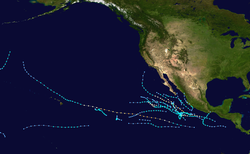
An average Pacific hurricane season features 15 tropical storms, 9 hurricanes, and 4 major hurricanes, and features an Accumulated Cyclone Energy (ACE) count of 132. In 2000, there were a below-average number of hurricanes and major hurricanes, though there was an above-average number of named storms. As a whole, the season was below-average, having a total of 95 ACE and featuring 19 tropical storms, 6 hurricanes, and 2 major hurricanes. A majority of the storms were weak and short-lived.
The first storm, Hurricane Aletta, formed on May 22 and peaked as a Category 2 hurricane. Tropical Storm Bud was a relatively weak tropical storm, affecting portions of Mexico. Hurricane Carlotta was the strongest storm of the month, peaking as a high-end Category 4 hurricane. Carlotta caused 18 fatalities after sinking a Lithuanian freighter. Following Carlotta, Four-E, Tropical Storm Upana, and Five-E formed in July, all 3 of which were weak and short-lived.
Systems
[edit]January
[edit]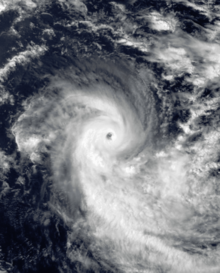
10 storms formed in the month of January, of which 6 were named by their respective agencies. Babiola was the first storm of the season, intensifying into one of the 4 storms that attained hurricane-force winds. Iris was an unusually small tropical cyclone, weakening while passing through Vanuatu. Connie was the strongest storm of the month, becoming an intense tropical cyclone and causing 3 fatalities.
| Storm name | Dates active | Max wind km/h (mph) |
Pressure (hPa) |
Areas affected | Damage (USD) |
Deaths | Refs |
|---|---|---|---|---|---|---|---|
| Babiola | January 3–12 | 155 (100) | 950 | Île Amsterdam | None | None | |
| 06F | January 3–6 | 45 (30) | 1004 | None | None | None | |
| Iris | January 6–10 | 150 (90) | 964 | Vanuatu, Fiji | None | None | |
| 03 | January 12–26 | Not specified | Unknown | Madagascar | Unknown | Unknown | [citation needed] |
| 07F | January 16–16 | Not specified | Not specified | None | None | None | |
| 08F | January 20–26 | 75 (45) | 996 | None | None | None | |
| Jo | January 23–27 | 120 (75) | 972 | None | None | None | |
| Kirrily | January 24–February 2 | 140 (85) | 975 | None | None | None | |
| Connie | January 25–February 1 | 185 (115) | 930 | Mauritius, Réunion, Southern Africa | Unknown | 3 | [5][6] |
| Damienne | January 30–February 7 | 65 (40) | 994 | None | None | None |
February
[edit]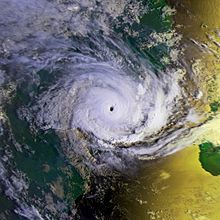

February saw the formation of 10 systems, of which 7 were named. Leon–Eline, the first storm of the month, was the longest-lasting Indian Ocean tropical cyclone, causing significant damages in Madagascar and much of Southern Africa. Leon–Eline was tied for strongest storm of the month with Cyclone Norman. Gloria made landfall on Madagascar weeks after Leon–Eline made landfall, contributing to the early 2000 Madagascar floods. Steve traversed the northern and western coasts of Australia, making 4 landfalls in the process.
| Storm name | Dates active | Max wind km/h (mph) |
Pressure (hPa) |
Areas affected | Damage (USD) |
Deaths | Refs |
|---|---|---|---|---|---|---|---|
| Leon–Eline | February 1–29 | 185 (115) | 930 | Mauritius, Réunion, Rodrigues, Madagascar, Mozambique, South Africa, Swaziland, Malawi, Botswana, Namibia | >$309 million | 114-722 | [nb 1] |
| TD | February 7–8 | Not specified | 1004 | Mariana Islands | None | None | |
| Marcia | February 14–18 | 65 (40) | 995 | None | None | None | |
| Felicia | February 18–24 | 110 (70) | 975 | None | None | None | |
| Kim | February 23–29 | 165 (105) | 935 | French Polynesia | Minimal | None | |
| Gloria | February 27–March 10 | 95 (60) | 985 | St. Brandon, Tromelin Island, Madagascar, Mozambique | Unknown | 66 | [nb 2] |
| Steve | February 27–March 11 | 110 (70) | 975 | North Queensland, Northern Territory, Western Australia | $100 million | None | [7] |
| 13F | February 28–29 | 65 (40) | 994 | None | None | None | |
| Norman | February 29–March 9 | 185 (115) | 930 | Western Australia | None | None | |
| 09 | February 29–March 11 | Not specified | Unknown | None | None | None |
March
[edit]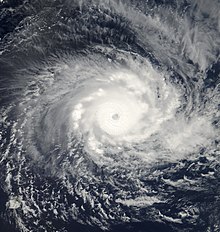
| Storm name | Dates active | Max wind km/h (mph) |
Pressure (hPa) |
Areas affected | Damage (USD) |
Deaths | Refs |
|---|---|---|---|---|---|---|---|
| 10 | March 1–3 | Not specified | Unknown | None | None | None | |
| Leo | March 4–8 | 95 (60) | 985 | French Polynesia | Minimal | None | |
| Mona | March 6–11 | 140 (85) | 960 | French Polynesia | Minimal | None | |
| 16F | March 9–12 | Not specified | Not specified | None | None | None | |
| 11 | March 10 | Not specified | Unknown | None | None | None | |
| Olga | March 15–20 | 95 (60) | 985 | None | None | None | |
| Hudah | March 24–April 9 | 220 (140) | 905 | St. Brandon, Tromelin Island, Rodrigues, Madagascar, Mozambique | Unknown | 114 | [8][9] |
| BOB 01 | March 27–30 | 85 (50) | 998 | Andaman and Nicobar Islands, India | Minimal | None | |
| Vaughan | March 28–April 7 | 110 (70) | 985 | Queensland | None | None |
April
[edit]
10 systems formed in the month of April, of which 5 were named. The first storm of the month, Cyclone Tessi, made landfall on Australia as a Category 3 severe tropical cyclone on the Australian scale. Innocente was a long-lasting yet weak storm, with its remnants causing heavy rains on Mauritius. Cyclone Paul was the strongest storm of the month, peaking with a minimum central pressure of 915 hPa. Cyclone Rosita was a small yet powerful tropical cyclone, peaking with 10-min winds of 205 km/h (125 mph) and making landfall at peak intensity.
| Storm name | Dates active | Max wind km/h (mph) |
Pressure (hPa) |
Areas affected | Damage (USD) |
Deaths | Refs |
|---|---|---|---|---|---|---|---|
| Tessi | April 1–3 | 130 (80) | 980 | Queensland | $50 million | None | [citation needed] |
| TD | April 5–6 | Not specified | Not specified | None | None | None | |
| 13 | April 7–15 | 95 (60) | 992 | Mozambique | None | None | |
| 18F | April 10 | Not specified | Not specified | None | None | None | |
| Innocente | April 12–24 | 70 (45) | 993 | Mauritius | None | None | |
| Paul | April 11–20 | 220 (140) | 915 | Cocos Islands | None | None | |
| Neil | April 12–17 | 75 (45) | 992 | Fiji | None | None | |
| Rosita | April 14–21 | 205 (125) | 930 | Western Australia | None | None | |
| 20F | April 29–30 | 75 (45) | 996 | Queensland | Minimal | None | [citation needed] |
| 21F | April 30–May 1 | 75 (45) | 1000 | Queensland | Minimal | None | [citation needed] |
May
[edit]
| Storm name | Dates active | Max wind km/h (mph) |
Pressure (hPa) |
Areas affected | Damage (USD) |
Deaths | Refs |
|---|---|---|---|---|---|---|---|
| 22F | May 3–8 | 75 (45) | 1001 | None | None | None | |
| Damrey (Asiang) | May 4–12 | 165 (105) | 930 | Caroline Islands | None | None | |
| 23F | May 6 | Not specified | Not specified | None | None | None | |
| Longwang (Biring) | May 17–20 | 85 (50) | 990 | Philippines, Ryukyu Islands | None | None | |
| TD | May 17–18 | Not specified | 1000 | None | None | None | |
| Aletta | May 22–28 | 165 (105) | 970 | Southwestern Mexico | None | None | |
| 03W (Konsing) | May 20–22 | 55 (35) | 1002 | Philippines, Taiwan | None | None | |
| 24F | May 20–23 | 75 (45) | 1002 | None | None | None | |
| 04W | May 30–June 1 | 55 (35) | 1002 | Vietnam | None | None |
June
[edit]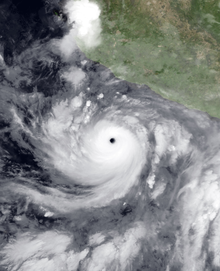
June tied with November for least active month of 2000. 5 storms developed, of which 2 developed gale-force winds and were named by their respective agencies. Tropical Storm Bud was the first named storm, affecting Western Mexico. Hurricane Carlotta was the strongest storm of the month, becoming a high-end Category 4 hurricane. Carlotta caused the deaths of 18 people after sinking the M/V Linkuva.
| Storm name | Dates active | Max wind km/h (mph) |
Pressure (hPa) |
Areas affected | Damage (USD) |
Deaths | Refs |
|---|---|---|---|---|---|---|---|
| One | June 7–8 | 45 (30) | 1008 | Mexico, Texas | None | None | |
| Bud | June 13–17 | 85 (50) | 994 | Revillagigedo Islands, Baja California Peninsula | Minimal | None | |
| Carlotta | June 18–25 | 250 (155) | 932 | Mexico | Minimal | 18 | [10] |
| TD | June 18 | 55 (35) | 1002 | South China | None | None | |
| Two | June 23–25 | 55 (35) | 1008 | None | None | None |
July
[edit]

| Storm name | Dates active | Max wind km/h (mph) |
Pressure (hPa) |
Areas affected | Damage (USD) |
Deaths | Refs |
|---|---|---|---|---|---|---|---|
| Kirogi (Ditang) | July 2–8 | 155 (100) | 940 | Japan | $140 million | 5 | [11][12] |
| Kai-tak (Edeng) | July 3–10 | 140 (85) | 960 | Philippines, Taiwan, East China, Korea | Unknown | 188 | [13] |
| Four-E | July 6–7 | 45 (30) | 1007 | None | None | None | |
| 07W (Gloring) | July 11–13 | 55 (35) | 1000 | Philippines | None | None | |
| TD | July 11 | Not specified | 1000 | South China | None | None | |
| 08W | July 15–17 | 45 (30) | 996 | South China | None | None | |
| Tembin | July 17–23 | 75 (45) | 992 | None | None | None | |
| Upana | July 20–24 | 75 (45) | 1006 | None | None | None | |
| 10W | July 20–22 | 45 (30) | 1000 | Philippines | None | None | |
| TD | July 21 | Not specified | 1004 | South China, Vietnam | None | None | |
| Five-E | July 22–23 | 55 (35) | 1005 | None | None | None | |
| Daniel | July 23–August 5 | 205 (125) | 954 | Hawaiian Islands, Aleutian Islands | None | None | |
| Bolaven (Huaning) | July 24–31 | 95 (60) | 980 | Philippines, Ryukyu Islands, Japan, Korea, Russian Far East | $21.6 million | None | [citation needed] |
| Emilia | July 26–30 | 100 (65) | 994 | Clarion Island, Revillagigedo Islands | None | None | |
| Chanchu | July 27–30 | 65 (40) | 996 | None | None | None | |
| Jelawat | July 31–August 12 | 155 (100) | 940 | Ryukyu Islands, East China | None | None |
August
[edit]
August was a very active month, featuring 24 systems, 16 of which were named by their respective agencies.
| Storm name | Dates active | Max wind km/h (mph) |
Pressure (hPa) |
Areas affected | Damage (USD) |
Deaths | Refs |
|---|---|---|---|---|---|---|---|
| TD | August 1–3 | Not specified | 1004 | Ryukyu Islands, Japan, Korea | None | None | |
| 01 | August 1–3 | Not specified | Unknown | None | None | None | |
| Alberto | August 3–23 | 205 (125) | 950 | West Africa, Bermuda, Iceland, Greenland, Jan Mayen | None | None | |
| Fabio | August 3–8 | 85 (50) | 1000 | None | None | None | |
| Gilma | August 5–11 | 130 (80) | 984 | None | None | None | |
| 14W | August 7–10 | 55 (35) | 1008 | None | None | None | |
| Four | August 8–11 | 55 (35) | 1009 | None | None | None | |
| Ewiniar | August 9–18 | 120 (75) | 975 | Mariana Islands | None | None | |
| Hector | August 10–16 | 130 (80) | 983 | None | None | None | |
| Beryl | August 13–15 | 85 (50) | 1007 | Mexico, Texas | $27 thousand | 1 | [14] |
| Ileana | August 13–17 | 110 (70) | 991 | Baja California Peninsula, Mexico | None | None | |
| Wene | August 13–17 | 85 (50) | 1002 | None | None | None | |
| Chris | August 17–19 | 65 (40) | 1008 | None | None | None | |
| 17W | August 17–18 | 45 (30) | 1008 | None | None | None | |
| Bilis (Isang) | August 18–25 | 205 (125) | 920 | Philippines, Taiwan, China, South Korea, Ryukyu Islands, Guam | $668 million | 71 | [15] |
| TD | August 18–20 | Not specified | 1004 | Japan | None | None | |
| Debby | August 19–24 | 140 (85) | 991 | Lesser Antilles, Greater Antilles, Turks and Caicos, Florida | $735 thousand | 1 | [16] |
| Kaemi | August 18–23 | 75 (45) | 985 | Vietnam, Cambodia | None | 14 | [17] |
| BOB 02 | August 23–24 | 45 (30) | 994 | Western India | $170 million | 131 | [18] |
| Prapiroon (Lusing) | August 25–September 1 | 130 (80) | 965 | Japan, Taiwan, China, Korea, | $6.14 billion | 75 | [19][citation needed] |
| Maria | August 27–September 2 | 75 (45) | 985 | China | None | None | |
| John | August 28–September 1 | 110 (70) | 994 | None | None | None | |
| Kristy | August 31–September 3 | 65 (40) | 1004 | None | None | None | |
| TD | August 31–September 1 | Not specified | 1004 | None | None | None | |
| Saomai (Osang) | August 31–September 16 | 175 (110) | 925 | Northern Mariana Islands, Guam, Japan, China, South Korea, North Korea, Russia | $6.3 billion | 28 | [20][21][22] |
September
[edit]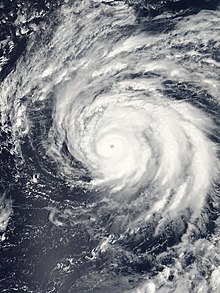

| Storm name | Dates active | Max wind km/h (mph) |
Pressure (hPa) |
Areas affected | Damage (USD) |
Deaths | Refs |
|---|---|---|---|---|---|---|---|
| Ernesto | September 1–3 | 65 (40) | 1008 | None | None | None | |
| TD | September 1 | Not specified | 1004 | None | None | None | |
| Bopha (Ningning) | September 4–11 | 85 (50) | 988 | Philippines, Taiwan, Ryukyu Islands | None | None | |
| Wukong (Maring) | September 4–10 | 140 (85) | 955 | South China, Vietnam, Laos | None | None | |
| Lane | September 5–14 | 155 (100) | 964 | Socorro Island, Baja California, Southwestern United States | None | None | |
| Nine | September 7–9 | 55 (35) | 1006 | Gulf Coast of the United States | None | None | |
| Florence | September 10–17 | 130 (80) | 985 | East Coast of the United States, Bermuda, Atlantic Canada | None | 3 | [23] |
| Gordon | September 14–18 | 130 (80) | 981 | Belize, Yucatán Peninsula, Cuba, East Coast of the United States, Atlantic Canada | $10.8 million | 26 | [24][25] |
| Sonamu | September 14–18 | 100 (65) | 980 | Japan | None | None | |
| TD | September 14–16 | Not specified | 1008 | None | None | None | |
| Helene | September 15–25 | 110 (70) | 986 | Lesser Antilles, Puerto Rico, Hispaniola, Jamaica, Cuba, Isle of Youth, Eastern United States, Atlantic Canada | $16 million | 2 | [26][27] |
| Miriam | September 15–17 | 65 (40) | 1004 | Mexico | $793 thousand | None | |
| Shanshan | September 17–24 | 175 (110) | 925 | None | None | None | |
| Norman | September 20–22 | 85 (50) | 998 | Mexico | $13.3 million | 9 | [28] |
| Isaac | September 21–October 1 | 220 (140) | 943 | Cape Verde, Bermuda, Eastern United States, Bermuda, Eastern Canada, British Isles | Minimal | 1 | [29] |
| Joyce | September 25–October 2 | 150 (90) | 975 | Trinidad and Tobago, Windward Islands, Leeward Antilles | Unknown | None | |
| TD | September 27–29 | Not specified | 1006 | Vietnam | None | None | |
| 27W | September 27–October 2 | 55 (35) | 1008 | None | None | None | |
| Keith | September 28–October 6 | 220 (140) | 939 | Central America, Yucatán Peninsula, Mexico, Belize | $319 million | 68 | [30][31][32] |
October
[edit]
| Storm name | Dates active | Max wind km/h (mph) |
Pressure (hPa) |
Areas affected | Damage (USD) |
Deaths | Refs |
|---|---|---|---|---|---|---|---|
| Olivia | October 2–10 | 100 (65) | 994 | Southwestern United States | None | None | |
| Leslie | October 4–7 | 75 (45) | 1006 | Cuba, Florida, Bermuda, Newfoundland | $950 million | 3 | [33][34] |
| 28W | October 6–13 | 55 (35) | 998 | Vietnam, South China | None | None | |
| TD | October 13–14 | Not specified | 1008 | None | None | None | |
| BOB 03 | October 15–19 | 65 (40) | 996 | Western India, Gujarat | Moderate | None | |
| Michael | October 15–19 | 155 (100) | 965 | Bermuda, Maine, Atlantic Canada | Unknown | None | |
| TD | October 17–18 | Not specified | 1008 | None | None | None | |
| Nadine | October 19–22 | 95 (60) | 999 | None | None | None | |
| Yagi (Paring) | October 21–28 | 130 (80) | 965 | Ryukyu Islands, Taiwan | None | None | |
| Xangsane (Reming) | October 24–November 1 | 140 (85) | 960 | Caroline Islands, Philippines, Taiwan, Japan | Unknown | 182 | [35][36] |
| Unnamed | October 25–29 | 100 (65) | 976 | New England, Atlantic Canada | Unknown | None | |
| Paul | October 25–29 | 75 (45) | 1003 | Hawaii | $70 million | None | |
| BOB 04 | October 25–29 | 65 (40) | 998 | Bangladesh, Odisha | $13 million | 77 | [37][38] |
| Bebinca | October 30–November 7 | 110 (70) | 980 | Philippines, South China | None | 26 | [39] |
November
[edit]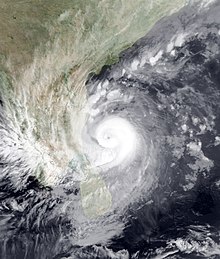
The month of November saw 5 systems form, tying with June for the least active month. 3 systems attained gale-force winds, though only 2 were given names by their respective agencies. Rosa was the first storm of the month, forming on November 3 and peaking as a tropical storm. 2 more systems formed before BOB 05, also known as the 2000 South India cyclone, formed in the Bay of Bengal. The cyclone peaked as an extremely severe cyclonic storm, making it the strongest storm of the month before weakening at landfall. The last storm of the month, Rumbia, affected the Philippines and Vietnam, causing 48 fatalities.
| Storm name | Dates active | Max wind km/h (mph) |
Pressure (hPa) |
Areas affected | Damage (USD) |
Deaths | Refs |
|---|---|---|---|---|---|---|---|
| Rosa | November 3–8 | 100 (65) | 993 | Southwestern Mexico, Central America | $21 thousand | None | |
| 32W | November 7–9 | 55 (35) | 1004 | Ryukyu Islands | None | None | |
| 02 | November 12–18 | Unknown | Unknown | None | None | None | |
| BOB 05 | November 26–30 | 190 (115) | 958 | South India, Somalia | $15 million | 12 | [40] |
| Rumbia (Toyang) | November 27–December 7 | 75 (45) | 990 | Philippines, Vietnam | $1 million | 48 | [17] |
December
[edit]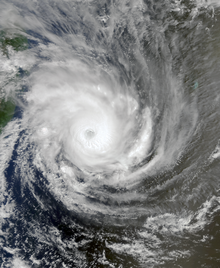

The month of December saw 7 systems form, with 4 of the storms being named by their respective agencies. The month began with Cyclone Sam, which intensified into a Category 5 severe tropical cyclone on the Australian scale, making landfall on Western Australia at peak intensity. Ulpiang was a short-lived storm that caused flooding and deaths in the Philippines. BOB 06, also known as the 2000 Sri Lanka cyclone was the strongest storm to hit Sri Lanka since 1978, being attributed to 9 deaths. 2 tropical depressions formed in the West Pacific before Soulik formed and rapidly intensified into a moderately strong typhoon. The year finished with Cyclone Ando, peaking offshore as an intense tropical cyclone.
| Storm name | Dates active | Max wind km/h (mph) |
Pressure (hPa) |
Areas affected | Damage (USD) |
Deaths | Refs |
|---|---|---|---|---|---|---|---|
| Sam | December 3–10 | 205 (125) | 935 | Western Australia | Minor | None | |
| Ulpiang | December 6–8 | 55 (35) | 1004 | Philippines | None | 3 | [41] |
| BOB 06 | December 23–28 | 165 (105) | 970 | Sri Lanka, India | Minimal | 9 | [42] |
| TD | December 24 | Not specified | 1008 | None | None | None | |
| TD | December 24 | Not specified | 1006 | None | None | None | |
| Soulik (Welpring) | December 29–January 4 | 150 (90) | 955 | None | None | None | |
| Ando | December 31–January 9 | 195 (120) | 925 | Seychelles, Agaléga, Tromelin, Mauritius, Réunion | None | 2 | [43][44] |
Global effects
[edit]- ^ The sum of the number of systems and fatalities in each basin will not equal the number shown as the total. This is because when systems move between basins, it creates a discrepancy in the actual number of systems and fatalities.
See also
[edit]Notes
[edit]2 Only systems that formed either on or after January 1, 2000 are counted in the seasonal totals.
3 Only systems that formed either before or on December 31, 2000 are counted in the seasonal totals.
4 The wind speeds for this tropical cyclone/basin are based on the IMD Scale which uses 3-minute sustained winds.
5 The wind speeds for this tropical cyclone/basin are based on the Saffir Simpson Scale which uses 1-minute sustained winds.
6 The wind speeds for this tropical cyclone are based on Météo-France which uses wind gusts.
- ^ a b In Madagascar, Eline killed at least 64 people, although subsequent Tropical Storm Gloria affected the same region just two weeks later. The death toll for both storms is 205, with 66 confirmed fatalities related to Gloria, resulting in 139 deaths potentially related to Eline. There were only 17 confirmed fatalities in Mozambique, although the death toll from the cyclone and preceding floods was around 700, with 150 deaths before Eline's arrival. Therefore, there are up to 550 deaths related to the storm in that country. Elsewhere, Eline killed 12 people in Zimbabwe and 21 in South Africa.
- ^ Gloria killed at least 66 people, although the exact toll was initially unknown due to disrupted communications.
References
[edit]- ^ "El Niņo and La Niņa Years and Intensities". 2021-02-10. Archived from the original on 2021-02-10. Retrieved 2021-02-11.
- ^ NOAA: 2000 Atlantic hurricane outlook. Climate Prediction Center (Report). National Oceanic and Atmospheric Administration. May 10, 2000. Retrieved January 26, 2008.
- ^ "Climate Prediction Center – Expert Assessments: Atlantic Hurricane Outlook". www.cpc.ncep.noaa.gov. Retrieved 2021-02-07.
- ^ "CNN.com - La Niña is dying. Or is it? - May 9, 2000". edition.cnn.com. Retrieved 2021-02-11.
- ^ "Island Cyclone Kills Two". AP News Archive. Associated Press. January 30, 2000.
- ^ "La Réunion échappe au cyclone Connie". Liberation Societe (in French). January 31, 2000.
- ^ Bureau of Meteorology. "BoM-Impact from Steve". Bureau of Meteorology. Retrieved 16 June 2006.
- ^ Centre des Cyclones Tropicaux de La Réunion. Saison Cyclonique – Sud-Ouest de l'océan Indien (PDF). La Saison Cyclonique A Madagascar (Report) (in French and English). La Réunion: Météo-France. Retrieved May 25, 2013.
- ^ "Cyclone Hudah bringing heavy rain to flood-hit Mozambique". ReliefWeb. Agence France-Presse. April 7, 2000. Retrieved September 29, 2014.
- ^ Lawrence; et al. (2007). "2000 Eastern Pacific Hurricane Summary". National Hurricane Center. Retrieved 2007-07-15.
- ^ "Typhoon Kirogi ravages Japanese cities, killing 3". The Milwaukee Journal Sentinel. Associated Press. July 9, 2000. Retrieved August 9, 2009.
- ^ Marcos Calo Medina (July 9, 2000). "Typhoon Hits Taiwan". Associated Press. Archived from the original on October 26, 2012. Retrieved August 9, 2009.
- ^ 2000 Annual Tropical Cyclone Report (PDF) (Report). p. 47. Retrieved February 7, 2021.
- ^ Stacy R. Stewart (November 14, 2000). Tropical Storm Beryl Tropical Cyclone Report (PDF) (Report). National Hurricane Center. p. 2. Retrieved December 17, 2013.
- ^ 2000 Annual Tropical Cyclone Report (PDF) (Report). p. 106. Retrieved February 7, 2021.
- ^ "Keys begins evacuating as Debby moves toward Florida". CNN. Miami, Florida. August 23, 2000. Archived from the original on October 8, 2007. Retrieved April 24, 2013.
- ^ a b Dartmouth Flood Observatory (February 14, 2001). "2000 Global Register of Extreme Flood Events". Dartmouth College. Retrieved 20 January 2014.
- ^ Report on Cyclonic Disturbances Over North Indian Ocean During 2000 (PDF) (Report). India Meteorological Department. February 2001. p. 14. Retrieved 2015-05-22.
- ^ 2000 Annual Tropical Cyclone Report (PDF) (Report). p. 118. Retrieved February 7, 2021.
- ^ Kitamoto Asanobu. "Typhoon 200014 (SAOMAI) – Disaster Information". Digital Typhoon. National Institute of Informatics. Retrieved 12 January 2014.
- ^ Lee, Charles (September 18, 2000). "Typhoon kills 8 South Koreans". Seoul, South Korea. United Press International.
- ^ "Nine killed, 76 hurt in Russia as Typhoon Saomai strikes". Moscow, Russia. Agence France-Pesse. September 18, 2000.
- ^ National Climatic Data Center (September 13, 2000). North Carolina Event Report (Report). p. 111. Retrieved May 8, 2008.
- ^ Stacy R. Stewart (May 14, 2001). Hurricane Gordon Tropical Cyclone Report (PDF) (Report). National Hurricane Center. p. 3. Retrieved January 1, 2013.
- ^ "Gordon's aftermath leaves Southeast soggy". CNN. Associated Press. September 19, 2000. Archived from the original on October 6, 2007. Retrieved May 26, 2011.
- ^ Eric S. Blake; Lixion A. Avila (October 17, 2000). "Tropical Storm Helene Tropical Cyclone Report" (PDF). National Hurricane Center. p. 2. Retrieved April 2, 2012.
- ^ "Storm Data September 2000" (PDF). National Climatic Data Center. National Oceanic and Atmospheric Administration. Archived from the original (PDF) on December 3, 2013. Retrieved December 18, 2013.
- ^ Staff Writer (2000-09-21). "Tropical Storm Norman Forms Off Southwest Coast". San Jose Mercury News. Retrieved 2008-09-29.
- ^ Richard J. Pasch (December 18, 2000). "Tropical Cyclone Report: Hurricane Isaac" (PDF). National Hurricane Center. p. 2. Retrieved October 30, 2007.
- ^ Jack Beven (January 21, 2001). Tropical Cyclone Report: Hurricane Keith (PDF) (Report). National Hurricane Center. p. 3. Retrieved June 4, 2013.
- ^ Jay Lawrimorea; Michael Halpert; Gerald Bell; Matthew Menne; Bradfield Lyon; Russell Schnell; Karin Gleason; David Easterling; Wasil Thiaw (2001). "Climate Assessment for 2000". Bulletin of the American Meteorological Society. 82 (6): 1304. Bibcode:2001BAMS...82.1304L. doi:10.1175/1520-0477(2001)082<1304:CAF>2.3.CO;2.
- ^ "Storm, cold kill 27 in Mexico". ReliefWeb. Agence France-Presse. October 10, 2000. Retrieved June 4, 2013.
- ^ James L. Franklin; Daniel P. Brown (2000-11-05). Tropical Storm Leslie Tropical Cyclone Report (Subtropical Depression One) (PDF) (Report). National Hurricane Center. p. 3. Retrieved 2010-11-13.
- ^ Susan Candiotti (2000-10-04). "Miami bails out after floods take city by storm". CNN. Archived from the original on 2007-02-04. Retrieved 2010-11-24.
- ^ 2000 Annual Tropical Cyclone Report (PDF) (Report). p. 181. Retrieved February 7, 2021.
- ^ "Fate of SQ006". Channel News Asia. Archived from the original on 5 November 2008. Retrieved 31 October 2008.
- ^ "25 dead, hundreds missing in Bangladesh cyclone". ReliefWeb. Deutsche Presse Agentur. 2000-10-29. Retrieved 2015-05-22.
- ^ "Death toll rises in Bangladesh storms". BBC. 2000-10-29. Retrieved 2015-05-22.
- ^ 2000 Annual Tropical Cyclone Report (PDF) (Report). p. 188. Retrieved February 11, 2021.
- ^ Report on Cyclonic Disturbances Over North Indian Ocean During 2000 (PDF) (Report). India Meteorological Department. February 2001. p. 36. Retrieved 2015-05-22.
- ^ "Monthly Global Tropical Cyclone Summary December 2000". australiasevereweather.com. Retrieved 2021-02-03.
- ^ Vijitha Silva (2001). "Cyclone wreaks havoc across northern Sri Lanka". World Socialist Web Site. Archived from the original on 15 December 2006. Retrieved January 4, 2007.
- ^ "Monthly Global Tropical Cyclone Summary January 2001". Retrieved 2014-07-07.
- ^ Cyclone Season 2000–2001. RSMC La Réunion (Report). Météo-France. Retrieved 2014-07-07.
External links
[edit]| Tropical cyclone year articles (2000–2009) |
|---|
| 2000, 2001, 2002, 2003, 2004, 2005, 2006, 2007, 2008, 2009 |
Regional Specialized Meteorological Centers
- US National Hurricane Center – North Atlantic, Eastern Pacific
- Central Pacific Hurricane Center – Central Pacific
- Japan Meteorological Agency – NW Pacific
- India Meteorological Department – Bay of Bengal and the Arabian Sea
- Météo-France – La Reunion – South Indian Ocean from 30°E to 90°E
- Fiji Meteorological Service – South Pacific west of 160°E, north of 25° S
Tropical Cyclone Warning Centers
- Meteorology, Climatology, and Geophysical Agency of Indonesia – South Indian Ocean from 90°E to 141°E, generally north of 10°S
- Australian Bureau of Meteorology (TCWC's Perth, Darwin & Brisbane) – South Indian Ocean & South Pacific Ocean from 90°E to 160°E, generally south of 10°S
- Papua New Guinea National Weather Service – South Pacific Ocean from 141°E to 160°E, generally north of 10°S
- Meteorological Service of New Zealand Limited – South Pacific west of 160°E, south of 25°S
![]() This article incorporates public domain material from websites or documents of the National Weather Service.
This article incorporates public domain material from websites or documents of the National Weather Service.
 KSF
KSF